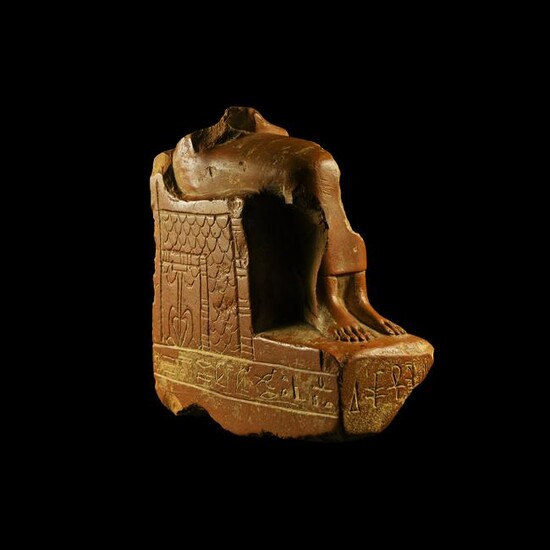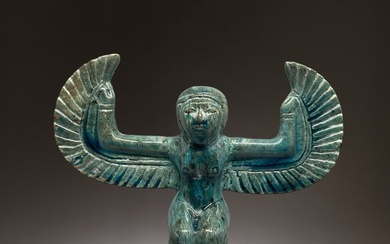Egyptian Seated Isis Statue Fragment
Late Period, 664-332 BC. A carved limestone figure fragment of the seated goddess Isis, comprising the lower body and throne; the sides of the seat decorated with a feather pattern and the sema-tawy motif, symbolising the unification of Upper and Lower Egypt; hieroglyphic text to the dorsal pillar and base with a dedication to Isis worshipped in the Fayyum area, possibly in the town of Crocodilopolis (Arsinoe), the most important centre of the region. See Zecchi, M., Geografia religiosa del Fayyum. Dalle origini al IV sec. a. C., Imola, 2001; Erman, A., Grapow, H., Wörterbuch der ägyptischen Sprache, Leipzig, Berlin, 1926-1963. 665 grams, 98mm (4"). From an important English collection; acquired by Seward Kennedy, prior to 1969; accompanied by an academic report by Dr Alberto Maria Pollastrini and by a geological scholarly report no.TL5382 by Dr Ronald Bonewitz. The two short inscriptions, roughly engraved on the base and introduced by the offering formula Hetep-di-neswt, could indeed include two hieroglyphic toponyms related to this particular region: Shedyt 'Crocodilopolis' (Wb IV, 567, 4) and Ta-She 'The Lake' (Wb IV, 397, 6"). The cult of Isis seems to have been more popular in the Fayyum starting from the Late and Graeco-Roman periods (Zecchi 2001, 73-75"). The inscription reads: Back pillar: '[...] the great, mother of the god, mistress of the sky, mistress of the gods, like Re, forever.' Base, left side: 'An offering given by the king to Isis, she who comes from Shedyt (?), great of magic, forever.' Base, right side: 'An offering given by the king to Isis, the great, mother of god, mistress of sky, (of /residing in Ta-) She.'
Condition Report: Fair condition.
View it on
Sale price
Estimate
Time, Location
Auction House
Late Period, 664-332 BC. A carved limestone figure fragment of the seated goddess Isis, comprising the lower body and throne; the sides of the seat decorated with a feather pattern and the sema-tawy motif, symbolising the unification of Upper and Lower Egypt; hieroglyphic text to the dorsal pillar and base with a dedication to Isis worshipped in the Fayyum area, possibly in the town of Crocodilopolis (Arsinoe), the most important centre of the region. See Zecchi, M., Geografia religiosa del Fayyum. Dalle origini al IV sec. a. C., Imola, 2001; Erman, A., Grapow, H., Wörterbuch der ägyptischen Sprache, Leipzig, Berlin, 1926-1963. 665 grams, 98mm (4"). From an important English collection; acquired by Seward Kennedy, prior to 1969; accompanied by an academic report by Dr Alberto Maria Pollastrini and by a geological scholarly report no.TL5382 by Dr Ronald Bonewitz. The two short inscriptions, roughly engraved on the base and introduced by the offering formula Hetep-di-neswt, could indeed include two hieroglyphic toponyms related to this particular region: Shedyt 'Crocodilopolis' (Wb IV, 567, 4) and Ta-She 'The Lake' (Wb IV, 397, 6"). The cult of Isis seems to have been more popular in the Fayyum starting from the Late and Graeco-Roman periods (Zecchi 2001, 73-75"). The inscription reads: Back pillar: '[...] the great, mother of the god, mistress of the sky, mistress of the gods, like Re, forever.' Base, left side: 'An offering given by the king to Isis, she who comes from Shedyt (?), great of magic, forever.' Base, right side: 'An offering given by the king to Isis, the great, mother of god, mistress of sky, (of /residing in Ta-) She.'
Condition Report: Fair condition.




